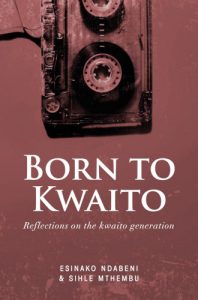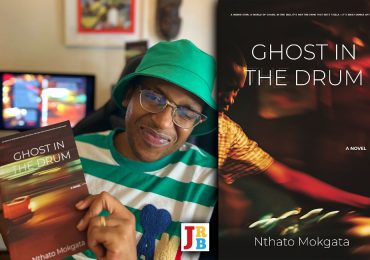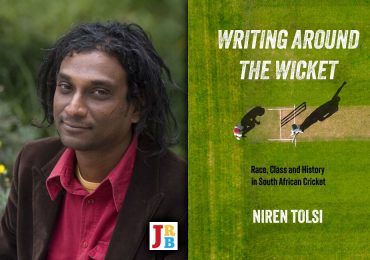Born to Kwaito: Reflections on the Kwaito Generation cranks up the volume of the unsung and barely documented soundtrack of ‘freedom’, writes Ntombizikhona Valela.
 Born to Kwaito: Reflections on the Kwaito Generation
Born to Kwaito: Reflections on the Kwaito Generation
Esinako Ndabeni and Sihle Mthembu
BlackBird Books, 2018
Born to Kwaito: Reflections on the Kwaito Generation is a political book. This is important, because the act of archiving and remembering Black lived experience is political. In South Africa, joy is political. For many in the midst of repression, music was the chief means by which joy could be communicated. And to be able to express joy through music at the dawn of a new dispensation, without surveillance and with great abandon, was just as important and as political an act as it was when music was a tool of protest. Authors Esinako Ndabeni and Sihle Mthembu provide us, then, with a fresh opportunity to think through the meaning of the years following the election of Nelson Mandela, and they do this by cranking up the volume of the unsung and barely documented soundtrack of ‘freedom’.
Not that the realities of Black life fell by the wayside when democracy arrived in South Africa: just that it was kwaito artists who assumed the mantle and continued the narration of the experiences of Black youth. It is important to think about kwaito as more than just a genre: it is a culture. Like hip-hop—and, despite the proliferation of comparisons between the two, this is where I believe the similarities start and end—kwaito was so huge that other aspects of society could not avoid being influenced by it. Think of the vocabulary of the television show Jam Alley (influenced mainly by its firebrand presenter Vinolia ‘V-Mash’ Mashego); of the aesthetics of the street clothing (captured best, perhaps, by the Loxion Kulca brand); of the depictions of life ekasi through shows like Yizo Yizo. Kwaito was everywhere and, to some, it was everything.
My earliest encounter with kwaito was secretly watching Lebo Mathosa and Thembi Seete sing, rap, twerk and wind their waists alongside Junior Sokhela and Theo Nhlengethwa in the music video for Boom Shaka’s ‘It’s About Time’ (1993). I confess to watching this video in secret because of the respectability politics that surrounded young Black women like Mathosa and Seete then: as the book points out, these women had labels of shame like ‘unondatshaza’ and ‘straat meid’ attached to them. ‘It’s About Time’ now enjoys frequent rotation on Mzansi Music (a gift for those of us in need of access to a visual archive no longer en vogue), but I can’t watch it without recalling the warnings I used to receive from elder women against becoming a ‘loose woman’. Mandela himself is said to have wagged his finger at the group, stating ‘Andiyifuni iBoom Shaka’, precisely because of the two frontwomen’s shameless booty shaking.
Where there is shame, you’re bound to find silence, and a crucial and timely intervention that Born to Kwaito makes is its confrontation of rape culture in kwaito, including its discussion of the men who have been at the centre of allegations of sexual assault and the exploitation of young women artists. On this subject, at a time when the #MeToo movement has earned global attention, Ndabeni and Mthembu do not mince their words. And their words are essential, defying the tradition of sweeping violence against Black women under the carpet. The fact that it has taken over two decades to barely mute self-professed ‘Pied Piper’ R Kelly speaks to the extent to which Black girls and Black women are not protected, believed or defended. So to declare unequivocally that Arthur Mafokate ‘represents a toxic masculinity and a co-opting of the very notion of artistic autonomy, placing him at odds with the aspirations of Black excellence and joy that are at the core of the music’s roots’, or to state the rape convictions of Ignatius ‘Dr Mageu’ Ntshebele and Sipho ‘Brickz’ Ndlovu (the latter being out on bail pending appeal) in conjunction with their roles in the genre, is an important step in the right direction of not letting artists’ behaviour slide because of the hits they churned out.
Oddly, the book does not start at the beginning of the kwaito movement, but rather somewhere in the middle. It zooms in on TKZee, Mapaputsi and Mandoza, while leaving out a number of significant moments—the era of ‘Sokoloko’, ‘Thobela’, ‘Ok’salayo’, ‘Abuti Yo’ and others among them. But even this honed-in-on middle era is left incomplete. I find it strange, for example, that the book ignores Adilah, the group that picked up where Boom Shaka left off, in terms of the vocal-rap-dancehall mash-up. Thembisile Ntaka, Karabo Motlhabi, Refiloe Motha, Letang Tlome and Itumeleng Kgosana’s Coca-Cola Popstars win fifteen years ago resulted in a reality TV import rooting itself in South Africa’s culture, more than any other series at the turn of the century since Shell Road to Fame. To hop, skip and jump over this is a little startling, to say the least.
On the other hand, the book does much to illuminate the sheer volume of academic writing centred on kwaito. The academy seems to have done a decent job of thinking about the contributions it made to South African political and feminist discourse, but I commend Ndabeni for calling out certain problematic conclusions drawn by scholars—linking the depiction of women’s sexuality in kwaito music videos to pornography, for example. What is missing, however, are the voices of the story-chasers of the early nineties: the likes of Sandile Memela, who wrote in Tribute Magazine of the ‘new urban music explosion of Johannesburg’ and of cultural commentators Bongani Madondo and Maria McCloy (McCloy’s breaththrough profile of TKZee was published twenty years ago this year—the same year the group’s breakout, game-changing album Halloween dropped, in October 1998).
Another lacuna in Born to Kwaito concerns the contributions of Sharon Dee—of ‘Local is Lekker’ fame—and filmmaker Leanne Cox. Their absence is slightly awkward as, in the book, the authors express disdain over the erasure of women and the automatic association of kwaito with men. Cox’s contribution to kwaito videography was significant, most notably in her SAMA Award-nominated video for Makhendlas’s ‘Iminwe’, while Dee was an important proponent of promoting local content across the music industry. In addition to how Jam Alley adopted lyrics from the likes of TKZee (who could ever forget the addition of ‘Cim’ iibane’ to their legendary audience chant ‘5-4-3-2-1 yo’ time is up, soooorreeeee!’—?), I recall the presenters and the audience adopting the phrase ‘local is lekker’— such was the impact of Dee’s hit single. (More recently, then-Deputy President Cyril Ramaphosa quoted the lyrics of ‘Local is Lekker’ in a speech at the the Proudly South African Buy Local Summit in Sandton in 2016.)
Shows like Jam Alley and Ezimtoti provided an important platform for artists who had just broken into the industry: they were crucial, in fact, to launching careers. Vinolia Mashego flexed her acting muscles playing ad exec Hilda on Generations. Nimrod Nkosi would become one of South Africa’s pioneering post-democracy television hosts. Project Runway SA host and all-round it-girl Lerato Kganyago made her first television appearance when she was crowned Miss Jam Alley back in 2002. Even gospel veteran Keke was once a Jam Alley contestant. And who could forget nineties heartthrob Romeo Kumalo, who has gone on to become a captain of industry, including a stint as CEO of Vodacom? And who didn’t want a Jam Alley chocolate bar? (While we’re reminiscing, I would dare argue that ProVerb was among the few contestants who actually knew what freestyling was.) Jam Alley was to South African popular culture what In Living Color was to its cognate in the United States, when it came to being situated within a significant musical and cultural moment. I would have thought that Mthembu’s recollection of visiting legendary producer David ‘D-Rex’ Campos, whose partnership with Mapaputsi would give us ‘Izinja’ and ‘Kleva’, at his present home in Amanzimtoti, or Ndabeni’s discussion of the importance of the women of kwaito, would have provided a springboard to broaden the scope of the book beyond the artists and into a critical take on South African culture generally.
While kwaito is more than music, it is important not to let its far-reaching influence distract us from zeroing in on the extensive discography that today’s artists, particularly in the hip-hop fraternity, continue to draw from. Whether it’s Gigi Lamayne incorporating tsotsitaal in her bars; or AKA’s bombastic ‘All Eyez on Me’, which contains a sample of Brenda Fassie’s ‘Ngiyakusaba’; or Kid X’s latest offering, ‘Mtan’ Omuntu’, which samples the late Tsakani ‘TK’ Mhinga’s 2003 hit ‘How Do You Feel’, following the typical kwaito formula of slowing down a house track. Of course, sampling is typical of kwaito itself. It could just be me, but in Boom Shaka’s ‘It’s About Time’ I hear echoes of the Fresh Prince and DJ Jazzy Jeff’s ‘Summertime’ (1991) (which in turn sampled Kool and The Gang’s ‘Summer Madness’, from 1974). South Africa’s unofficial national anthem ‘Sister Bettina’ (2006) was inspired by Aaliyah’s ‘Try Again’ (2000), from the Timbaland-produced Romeo Must Die soundtrack (and not 2001’s ‘Rock The Boat’, as Born to Kwaito‘s authors claim). TKZee’s iconic ‘Palafala’ (1997) samples Janet Jackson’s ‘Got Til It’s Gone’ (released just two months earlier), which in turn samples Joni Mitchell’s ‘Big Yellow Taxi’. (Incidentally, the Grammy Award-winning music video for ‘Got Til It’s Gone’ was set in a bar in apartheid-era South Africa, and ends with a shot of a bottle smashing against a ‘Slegs Blankes’ sign.)
Kwaito’s transatlantic borrowings read to me as a deliberate attempt to situate itself within a broader global context. It is important to remember that South Africa’s isolation from the global community—a consequence of anti-apartheid boycotts—continued into the late eighties, when political mobilisation had rung the death knell for National Party repression. It was this context that spurred artists to create a sound that would equip young people to party in step with the rest of the world, and that has enabled kwaito to stand the test of time—and to reach beyond our borders. It is not unusual to hear hits by the godfather of kwaito, M’du, being blasted at clubs in Nairobi.
Born to Kwaito offers the reader a timeline of which kwaito artists emerged as big players at various points in the genre’s evolution, but what it doesn’t do is really give us the music: the density and longevity of its moment. It’s a little puzzling to read the first book about kwaito and discover that some of the genre’s key actors are not satisfactorily dealt with. There’s no rigorous engagement with the musical contributions of artists such as Spikiri, Oskido, Moses Taiwa Molelekwa, Robbie Malinga and others, beyond just name-dropping. This is not to mention Lazarus Serobe, Sony BMG’s first Black MD, who signed a number of kwaito artists during his tenure. As a result, Sony BMG became the first mainstream record label to have kwaito musicians on its roster—signifying that kwaito had hit the big time. In the context of hip-hop, for example, it would be considered blasphemy to talk about gangster rap without mentioning its patrons—the likes of Eric ‘Eazy-E’ Wright, who formed one third of West Coast outfit NWA and discovered Bone Thugs-N-Harmony. And it would be even more heinous to talk about the hip-hop artists who have dominated the pop charts over the past two decades without so much as a whisper of Missy Elliot’s name and the work she’s put in. Kwaito’s roots go similarly deep, but you don’t come away with that sense from this book.
Where Ndabeni and Mthembu must be commended, however, is that they have challenged us to further the work of preserving one of South Africa’s most important urban cultures. I don’t believe we should hail the authors as ‘brave’ for writing about a genre they were too young to appreciate, from a critical and historical perspective, at the time that it captured their—and the country’s—imagination. Such sentiments are boring, and they are in essence silenced by the very title of the book. In Born to Kwaito, Ndabeni and Mthembu are engaged in documenting a genre that offered a soundtrack to their lives, growing up in an era where the tag ‘born free’ was shoved down their throats, within a reality that was far from free from a repressive past. As writers they have recognised a jarring gap in the archive of our cultural history, and they have sought to fill this gap. And in doing so they have invited those of us interested in writing our Blackness into existence to take their prologue further.
- Ntombizikhona Valela is a historian whose research interest is in the hidden histories of the political and intellectual contributions of Black women of various movements of the Global South. Follow her on Twitter.






Congrats,
A well captured experience, for those who lived in those beats and dance moves, clothing and lingo and those born after #lit or #Woke generation, will appreciate the times and energy that music, sound and subculture of that day (did) soothed the hearts and mind. Be it ama stokvel or street bashes, house parties and even bula boot, people from time to time gathered and had a good time, from one township to another, “ziya wa strong”! Music and dance is and will always be an important part of culture, evolution and communication. Music as a refuge and escape not to forget, a political tool to convey injustices and tell the story of a people.
Thank you for this piece, this is history and a treasured memory well recorded for generations to appreciate and reminisce.
Hello. I have the book and have read it so I can agree that there are some limitations. However, the authors made it plainly clear that this is not the definitive book on Kwaito. Also, you made an error: Kid X sampled “How do you feel” by TK on his song “Aunty” and not “Mntano muntu”.